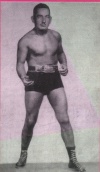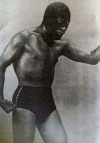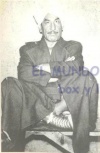Murciélago Velázquez: Difference between revisions
Flashmagic (talk | contribs) No edit summary |
I Like Lucha (talk | contribs) |
||
| (8 intermediate revisions by 4 users not shown) | |||
| Line 4: | Line 4: | ||
{{bioFields| | {{bioFields| | ||
|image= | |image=FB IMG 1470198229633.jpg | ||
|name=Murciélago (Bat) Velázquez | |name=Murciélago (Bat) Velázquez | ||
|realName=Jesús Velázquez Quintero | |realName=Jesús Velázquez Quintero | ||
| Line 15: | Line 15: | ||
|debut=[[April 3]], [[1938]] - [[Arena México]] | |debut=[[April 3]], [[1938]] - [[Arena México]] | ||
|lostmaskto=[[Octavio Gaona]] - [[July 18]], [[1939]] - [[Arena México]] | |lostmaskto=[[Octavio Gaona]] - [[July 18]], [[1939]] - [[Arena México]] | ||
|height= | |height=170 cm (5 ft 7 in) | ||
|weight= | |weight=75 kg (165 lb) | ||
|signatureMoves=La Filomena ([[Spin Kick]]), La Suástica ([[Swastika]]), La Noria | |signatureMoves=La Filomena ([[Spin Kick]]), La Suástica ([[Swastika]]), [[La Noria]] | ||
|titles=[[National Middleweight Title]] | |titles=[[National Middleweight Title]] | ||
}} | }} | ||
| Line 58: | Line 58: | ||
But after that glorious year he got lost in the shuffle once again until 1953, when the year end issue of Box y Lucha's statistics pointed him as the wrestler with more straight falls victories: six, but now against lesser opponents such as the charismatic Argentinian Bobbo Salvaje, Bob Norman or the rookie Chico Veloz. This media attention gained him a considerable push outside Mexico City as the rugged and grumpy veteran who was the nightmare of the local rookies. | But after that glorious year he got lost in the shuffle once again until 1953, when the year end issue of Box y Lucha's statistics pointed him as the wrestler with more straight falls victories: six, but now against lesser opponents such as the charismatic Argentinian Bobbo Salvaje, Bob Norman or the rookie Chico Veloz. This media attention gained him a considerable push outside Mexico City as the rugged and grumpy veteran who was the nightmare of the local rookies. | ||
He made his last stride in the big arenas in 1955. In those buildings nobody was seeing him as more than "a name of the past" or "a former great", but he gained some momentum forming a team with the Jewish brawler Samar Seleem. They got over huge as "wild brawlers" who did not care about rules and got a strong tag team push defeating dream teams such as Cavernario Galindo and El Verdugo (who were the top two "wild brawlers" in the company's hierarchy), Tony Borne and Tony Barbetta, El Santo and [[Pancho Valentino]], Los Hermanos Shadow (Black Shadow and Blue Demon) and Tarzán López and Enrique Llanes. But in a match against López and Henry Pilusso, things got so out of control with the fans that the commissioner Manuel Muñoz, who had been in that role for only a year and had already built himself a reputation as being severely strict with the rules, barred them for life from Mexico City. That political decision taken by just one man broke up a team that in just a few months had amassed both a huge cult rudo following and a rabid legion of haters. | He made his last stride in the big arenas in 1955. In those buildings nobody was seeing him as more than "a name of the past" or "a former great", but he gained some momentum forming a team with the Jewish brawler Samar Seleem. They got over huge as "wild brawlers" who did not care about rules and got a strong tag team push defeating dream teams such as Cavernario Galindo and El Verdugo (who were the top two "wild brawlers" in the company's hierarchy), Tony Borne and [[Tony Barbetta]], El Santo and [[Pancho Valentino]], Los Hermanos Shadow (Black Shadow and Blue Demon) and Tarzán López and Enrique Llanes. But in a match against López and Henry Pilusso, things got so out of control with the fans that the commissioner Manuel Muñoz, who had been in that role for only a year and had already built himself a reputation as being severely strict with the rules, barred them for life from Mexico City. That political decision taken by just one man broke up a team that in just a few months had amassed both a huge cult rudo following and a rabid legion of haters. | ||
Seleem went to Monterrey, while Velázquez left the business and became an actor and movie script writer. He made his debut as an actor in the 1957 series "La Momia Azteca" (The Aztec Mummy) and wrote several original screenplays for movies such as Tlayucan (1961). He also appeared in several movies of the lucha adventures genre, and even wrote one, "El Señor Tormenta" (1962). | Seleem went to Monterrey, while Velázquez left the business and became an actor and movie script writer. He made his debut as an actor in the 1957 series "La Momia Azteca" (The Aztec Mummy) and wrote several original screenplays for movies such as Tlayucan (1961). He also appeared in several movies of the lucha adventures genre, and even wrote one, "El Señor Tormenta" (1962). | ||
| Line 82: | Line 82: | ||
== Gallery == | == Gallery == | ||
{{Gallery|name=Murcielagovelazquez.jpg}} | |||
{{gallery|name=MurcielagoVelazquez2.jpg|caption= Mexican Middleweight Title belt,1942}} | {{gallery|name=MurcielagoVelazquez2.jpg|caption= Mexican Middleweight Title belt,1942}} | ||
{{Gallery|name=FB IMG 1474746272056.jpg|caption=his creation [[La Filomena]]}} | |||
{{Gallery|name=FB IMG 1487396120515.jpg|caption=}} | |||
{{Gallery|name=389679_330320850356650_991411212_n.jpg|caption=}} | |||
[[Category:Deceased wrestlers]] | [[Category:Deceased wrestlers]] | ||
[[Category:Mexican wrestlers]] | [[Category:Mexican wrestlers]] | ||
[[Category:Former CMLL wrestlers]] | [[Category:Former CMLL wrestlers]] | ||
[[Category:La Arena bios]] | |||
Latest revision as of 22:55, 6 March 2021
Profile
| Murciélago (Bat) Velázquez | |||||||||||||||||||||||||||||
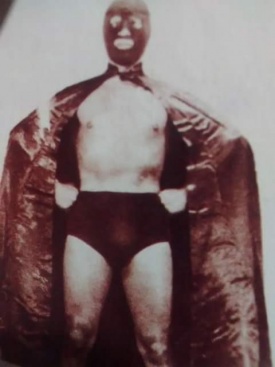 |
|
||||||||||||||||||||||||||||
Biography
Writing about Jesús "El Murciélago" Velázquez means writing about a whole era when lucha libre was on its infant stages, still developing.
Born Jesús Velázquez Quintero on February 22, 1910 in the small ranch of La Palma in Dolores Hidalgo, Guanajuato, he was one of the original dark and eccentric stars of the world of lucha libre.
His first appearance at Arena Mexico was on April 3, 1938, as "El Murciélago Enmascarado" (Masked Bat), having a tough match with Jack O'Brien, who won the match as the fierce rookie was disqualified, via ruling of excessive punishment. It should be noted that he was the second Mexican masked wrestler ever, and the fourth ever in Mexico, as his predecessors were El Enmascarado (Mexican wrestler Luis Núñez), La Maravilla Enmascarada (The Masked Marvel aka Ciclon MacKey) and El Enmascarado de Chicago.
Wearing a black hooded vest to the ring, and wrestling with black trunks and mask, he would have been an immediate sensation only because of his spectacular ring entrance, as he released small bats (as incredible as it sounds, considering what I have read in three different write-ups in magazines of the fifties and sixties, I'm thinking they were real ones) that would go flying over the heads of the screaming fans. But that was not the only thing that gave him that darkness aura, as he backed it up in the ring with a hard hitting brawling style mixing in scientific holds such as his creation, the swastika stretch.
His popularity rise was nothing but meteoric, and one month into his debut he was already wrestling people such as Dientes Hernández and Bobby Bonales. But there is an incident that made Velázquez look like such a cruel and evil heel, and no doubt is the first thing that most fans and writers think about when the name of Velázquez pops up. Many fans reading this must have guessed it by now. I am talking about the Merced Gómez incident.
Merced was a very tough rudo wrestler of the era. He was a hard hitter who had a well cut physique, resembling a welterweight boxer. In fact, Merced was a boxer who retired because he was losing sight in an eye after some blows to the head, and like many other failed boxers of the era tried to make a living as a professional wrestler. As the history goes, 14 days after his debut, the Enmascarado faced Merced. In the third fall, Murciélago was taking quite a beating, but was able to come back with a "filomena" spin kick (Ringo Mendoza style), another of the moves considered as his "creations" because he was the first to use it in the ring. That kick is mostly landed in the stomach of the opponent, but this one hit Gómez right in the face. He took a hard fall to the mat, and when he woke up everybody witnessed in silence how Merced's eye... wasn't there. But Murciélago still wanted more of the bloodied Merced, while the referee tried to stop the fight.
With this being wrestling, and in Mexico no less, there is a very blurry line between shoot and work. The widespread version of the incident is basically the one told above. Once I read in a magazine that Merced's lost eye was his healthy one, and losing almost all visibility so quickly caused him severe mental damage and he died very young. That can not be true, because Gómez kept wrestling for at least one more year.
Even though wrestling is a business where one man's disgrace is another man's ticket to stardom, I firmly believe this this is all a myth. The 1948 released book "15 años de lucha libre" (15 years of lucha libre) said that Merced had already lost that eye in boxing. And if there is need of furter proof, a month later they had a rematch that the Bat won as well, and as the legend goes, it was so brutal that his opponent's blows broke several of his ribs, seven to be more exact. But that may be another work of the era, as Murciélago was wrestling seven days after the match.
But work or not, there is no doubt this incident was a key part in the rising of the Velázquez legend as a heartless villain.
Years of hard work made Murciélago a charismatic figure that had matches with all the stars of the era. On August of 1939 he participated in a multiple week tournament to crown a National Middleweight champion. He defeated Jack O'Brien, Ciclón Veloz and Caballero Lee in grueling matches but lost the finals to Dientes Hernández. He did not give up and reached his well deserved "consagración" in 1940 when he rarely lost any matches, which lead to him starting a rivalry with Octavio Gaona.
On one side we had Murciélago, who had not had a lot of previous training. But he was so dedicated to the craft that he became a policeman as a day job just so he could improve his wrestling at the "Casino de la Policia", one of the first lucha schools. And on the other side, we had Gaona who was one of the mat masters of the era, known for his fine and smooth technical style. But since their matches were all-out brawls, it was all even. In fact one of their most famed bouts was a "super libre" no rules match where Gaona lost. That match lead to Gaona issuing a "mask vs. hair" challenge to Murciélago, which was accepted. And on July 18th of 1940, Gaona won - and El Murciélago Enmascarado died the same night "Murciélago" Velázquez was born!
Before losing the mask, he piled up four "cabelleras" won in mask defenses in straight weeks: old opponent Merced Gómez, Bobby Bonales, Dientes Hernández and Ciclón Veloz. Impressive by all accounts, since those matches were among the first of the kind ever held in the country, or any place for that matter. And I am sure that many fans of the era saw Gaona as the underdog in that bout.
The mask losing did not affect Velázquez' career at all, as his serious looking rudo face matched his personality. So of course, he stayed on top of the events and remained as one of the big names in the business, and a serious candidate for any titles that were up for grabs, like when on May 12, 1941, both he and Black Guzman (brother of El Santo) reached the finals of a tournament for the National Middleweight Title left vacant by Firpo Segura. That night, the nicknamed "Indio de Tulancingo" won the title.
But Murciélago did not give up, and had better luck when that same title was left vacant again, on December of 1941, as Black Guzmán won the NWA title of the same weight class. On January of 1942, he upset old nemesis Octavio Gaona in the finals of the tournament. Back then, as there was only a card a week, hot rivalries would span for years without losing a touch of interest, and this was seen as Velázquez' sweet revenge. Overall, he was a champion deserving of the title and had a good run.
Other of Velázquez' legendary career rivalries was the one with a young, hot up-and-coming wrestler that took his hair on January of 1943 in a mask vs. hair match. On March 19, 1943, that same man that took his hair, now took his belt. The newly crowned champion here was having a "vendetta" of his own, as years earlier he had wrestled under the guise of "El Murciélago Enmascarado II" until the original one complained to the commission that forced him to switch names. And having to adopt a new identity if he wanted to continue to wrestle, that young man became El Santo.
From since that feud was done to 1946, Velázquez got lost in the shuffle. He was still popular, but there was more interest in other wrestlers, such as Santo himself. But in that year 1946 he had a great resurgence push, piling up a record of winning 21 straight singles matches in just two falls. Two versions of the same tale say that the man stopping the streak was either Gory Guerrero or Pete Sherman, but what is for sure is that people with the name value of El Santo, Bobby Bonales and Tarzán López were among the beaten wrestlers.
But after that glorious year he got lost in the shuffle once again until 1953, when the year end issue of Box y Lucha's statistics pointed him as the wrestler with more straight falls victories: six, but now against lesser opponents such as the charismatic Argentinian Bobbo Salvaje, Bob Norman or the rookie Chico Veloz. This media attention gained him a considerable push outside Mexico City as the rugged and grumpy veteran who was the nightmare of the local rookies.
He made his last stride in the big arenas in 1955. In those buildings nobody was seeing him as more than "a name of the past" or "a former great", but he gained some momentum forming a team with the Jewish brawler Samar Seleem. They got over huge as "wild brawlers" who did not care about rules and got a strong tag team push defeating dream teams such as Cavernario Galindo and El Verdugo (who were the top two "wild brawlers" in the company's hierarchy), Tony Borne and Tony Barbetta, El Santo and Pancho Valentino, Los Hermanos Shadow (Black Shadow and Blue Demon) and Tarzán López and Enrique Llanes. But in a match against López and Henry Pilusso, things got so out of control with the fans that the commissioner Manuel Muñoz, who had been in that role for only a year and had already built himself a reputation as being severely strict with the rules, barred them for life from Mexico City. That political decision taken by just one man broke up a team that in just a few months had amassed both a huge cult rudo following and a rabid legion of haters.
Seleem went to Monterrey, while Velázquez left the business and became an actor and movie script writer. He made his debut as an actor in the 1957 series "La Momia Azteca" (The Aztec Mummy) and wrote several original screenplays for movies such as Tlayucan (1961). He also appeared in several movies of the lucha adventures genre, and even wrote one, "El Señor Tormenta" (1962).
Actually, not even counting the lucha genre films, he never really completely left the business as he trained wrestlers for a couple of years, and in an unexpected turn of events, in the early 60s he became the Distrito Federal lucha libre commissioner for a short time. From barred wrestler to "number one authority", quite a paradox.
By the late 60s he had left his acting career to concentrate on script writing. In total he wrote more than 30 scripts, between westerns, dramas and lucha movies. That was his job until his death, the midnight of May 26, 1972. Cause was a cirrhosis of the liver.
It was never said while he was alive because of not breaking kayfabe, but Velázquez' in-ring personality was the opposite of his actual personality, as his peers considered him a very friendly and peaceful man who loved to read philosophy and poetry books, and had a cultural level superior to most wrestlers' but was very humble about it.
Luchas de apuestas record
| Date | Apuesta | Winner(s) | Loser(s) | Arena and/or Place |
|---|---|---|---|---|
| 40/06/23 | hair | Murciélago Enmascarado | Merced Gómez | Arena México - Mexico City |
| 40/06/30 | hair | Murciélago Enmascarado | Bobby Bonales | Arena México - Mexico City |
| 40/07/04 | hair | Murciélago Enmascarado | Dientes Hernández | Arena México - Mexico City |
| 40/07/11 | hair | Murciélago Enmascarado | Ciclón Veloz | Arena México - Mexico City |
| 40/07/18 | mask | Octavio Gaona | Murciélago Enmascarado | Arena México - Mexico City |
| 43/01/?? | hair | El Santo | Murciélago Velázquez | Arena Coliseo- Mexico City |
Gallery
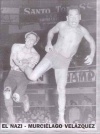 his creation La Filomena |

